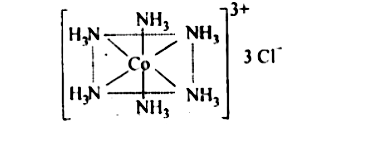WERNER’S THEORY OF COORDINATION COMPOUNDS
The main postulates of Werner's theory of coordination compounds are as follows
(a) Metals possess two type of valencies called
(i) primary valency which are ionisable (ii) secondary valency which are non ionisable
(b) Primary valency is satisfied by the negative ions and it that which a metal exhibits in the formatio of its simple salts
(c) Secondary valence are satisfied by neutral ligand or negative ligand and are those which metal exerciese in the formation of its complex ions. Every cation has a fixed number of secondary valencies which are directed in space about central metal ion in certain fixed directions e.g., in CoCl3−6NH3 valencies between Co and Cl are primary valencies and valencies between Co and NH3 are secondary in COCl3−6NH3 six ammonia molecules linked and thus account for structure of COCl3−6NH3 as follows in modern theory it is now referred as coordination number of central metal atom or ion.

Topper's Solved these Questions
Similar Questions
Characteristics OF Catalyst, Theory OF Catalysis || Intermediate Compound Formation Theory || Absorption Theory || Shape Selective Catalysis ||Zeolites|| Enzyme Catalysis
View SolutionProperties OF Coordination Compounds|| Magnetic moment OF Coordination Compounds|| Stability OF Coordination Compounds
View Solution
Knowledge Check
According to werner, the arrangement of 6 groups around the metal centre within the co-ordination sphere can lead to three possible geometries (For Q. 1 and Q. 2) : planar hexagon, trigonal prism and octahedral. For a particular geometry, if the groups (i.e. ligands) are arranged in different ways then the possibility of geometrical isomerism will arise.
A complex [PtCl2(NH3)4]2+ in WERNER 'S universe has a total 3 stereo-isomers possible. If Werner was present, then, according to him, what can be the probable shape of the complex ?Aplanar hexagonBtrigonal prisonCoctahedronDboth (a) and (b)Which of the following statements is INCORRECT about Werner's theory ?
APrimary valence is the same thing as oxidation state.BSecondary valence is the same thing as coordination number.CPrimary valence are satisfied by neutral molecules.DSecondary valences are directional whereas primary valences are non-directional.Which of the following are not postulates of Werner?
(P) In co-ordination compounds, metals show two types of linkage (valencies) primary and secondary
(Q) The primary valencies are normally ionisable. These are satisfied by negative ions.
(R) The secondary valency is equal to the co-ordination number and is fixed for a metal
(S) The ions/groups bound by the primary and secondary linkages to the metal have characteristic spatial arrangements corresponding to different coordination numbers
(T) Octahedral, Tetrahedral and Square planar geometrical shapes are more common in co-ordination compounds of transition metalsA(P), (Q), (R ) and (S)B(S) and (T)C(S)D(P), (Q), and (R )
Stability Of Coordination Compound
View SolutionWerner’s Coordination Theory||Crystal Field Theory||Splitting in Octahedral Field and Strength OF Ligands||Filling OF Electrons in Octahedral Field
View SolutionBonding in Co-ordination Compounds || Werner’s Co-ordination Theory Concept OF Primary Valency/Secondary Valency || Different test to Distinguish Compounds Formed by Werner
View SolutionWerner Theory 2
View SolutionWhich of the following are not postulates of Werner?
(P) In co-ordination compounds, metals show two types of linkage (valencies) primary and secondary
(Q) The primary valencies are normally ionisable. These are satisfied by netural molecules or negative ions. The secondary valency is equal to the co-ordination number and is fixed for a metal
The ions/groups bound by the primary and secondary linkages to the metal have characteristic spatial arrangements corresponding to different coordination numbers
(T) Octahedral, Tetrahedral and Square planar geometrical shapes are more common in co-ordination compounds of transition metals
View Solution
